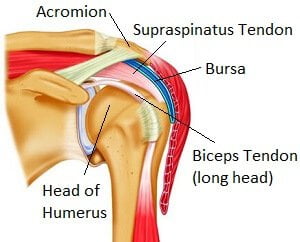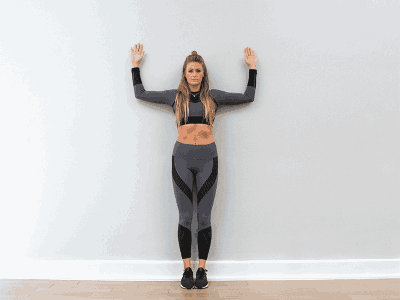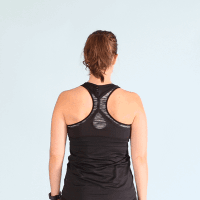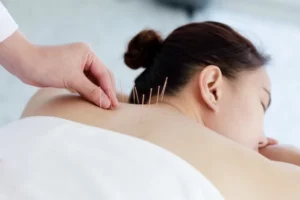Shoulder pain can be both debilitating and frustrating, often disrupting your daily life and activities. Among the various shoulder conditions, acromion pain is a common complaint that can cause discomfort and limit your range of motion. In this blog, we will delve into the world of acromion pain, exploring its causes, symptoms, and effective methods for relief and recovery. Whether you’re seeking answers for your own discomfort or aiming to better understand this condition, read on to discover insights that can help you on your journey to a pain-free shoulder.
Contents
What is Acromion Pain?
 Acromion pain, also known as acromioclavicular (AC) joint pain or shoulder impingement syndrome, is a condition characterized by discomfort or pain in the shoulder region, specifically around the acromion process. The acromion is a bony projection of the shoulder blade (scapula) that forms the highest point of the shoulder. It plays a crucial role in the stability and mobility of the shoulder joint.
Acromion pain, also known as acromioclavicular (AC) joint pain or shoulder impingement syndrome, is a condition characterized by discomfort or pain in the shoulder region, specifically around the acromion process. The acromion is a bony projection of the shoulder blade (scapula) that forms the highest point of the shoulder. It plays a crucial role in the stability and mobility of the shoulder joint.
Acromion pain typically occurs when there is irritation, inflammation, or compression of the structures in and around the AC joint, such as the tendons, ligaments, and bursa. This irritation can be caused by various factors, including repetitive overhead movements, trauma, or degenerative changes in the shoulder joint.
Common symptoms of acromion pain may include:
- Pain or tenderness at the top of the shoulder, particularly when reaching overhead or during specific arm movements.
- Limited range of motion in the shoulder, especially when raising the arm or reaching across the body.
- Pain that may radiate down the arm, sometimes mimicking the symptoms of conditions like rotator cuff injuries.
- Weakness or discomfort when lifting objects or performing activities that involve the affected shoulder.
Acromion pain can be acute or chronic and may interfere with daily activities and sleep. It is essential to diagnose the underlying cause of the pain accurately to determine the most appropriate treatment approach, which can range from conservative measures like rest, physical therapy, and anti-inflammatory medications to more invasive options such as corticosteroid injections or, in severe cases, surgery.
Understanding the Causes of Acromion Pain
Acromion pain, often associated with acromioclavicular (AC) joint pain or shoulder impingement syndrome, can arise from various underlying causes. Understanding these causes is crucial for proper diagnosis and effective treatment. Here are some common factors that contribute to acromion pain:
- Repetitive Overhead Movements: Activities or professions that involve frequent overhead movements, such as painting, swimming, or certain sports like tennis or baseball, can strain the structures around the AC joint. Over time, this can lead to inflammation and pain.
- Muscle Imbalances: Muscle imbalances around the shoulder can affect the position and movement of the acromion. Weakness or tightness in certain muscle groups, like the rotator cuff muscles or the muscles that stabilize the scapula, can contribute to pain and dysfunction.
- Trauma or Injury: A direct injury or trauma to the shoulder, such as a fall or collision, can damage the AC joint or the surrounding soft tissues, leading to pain and discomfort.
- Bursitis: Inflammation of the bursa sac, a fluid-filled cushioning structure around the AC joint, can result in acromion pain. Bursitis is often caused by repetitive friction or trauma.
- Bone Spurs: Over time, wear and tear on the AC joint can lead to the formation of bone spurs or osteophytes. These bony growths can impinge on nearby structures and cause pain.
- Arthritis: Various forms of arthritis, such as osteoarthritis or rheumatoid arthritis, can affect the AC joint. Arthritis causes inflammation and degeneration of joint tissues, leading to pain and limited mobility.
- Structural Anomalies: Some individuals may have congenital or structural anomalies that make them more prone to AC joint problems. These anomalies can affect the alignment of the joint and lead to pain.
- Poor Posture: Maintaining poor posture, especially when working at a computer or desk for extended periods, can contribute to acromion pain. Slouching or rounded shoulder posture can increase stress on the AC joint.
- Aging: As individuals age, the structures around the AC joint can naturally degenerate, further leading to pain and reduced joint function.
It’s essential to consult a healthcare professional for a proper diagnosis of the underlying cause of acromion pain. Once the cause is identified, an appropriate treatment plan can be developed. Treatment options may include physical therapy, rest, anti-inflammatory medications, corticosteroid injections, or, in severe cases, surgical interventions. Addressing the root cause of acromion pain is key to relieving discomfort and improving shoulder function.
Exercises to Heal Acromion Pain
Exercises can play a crucial role in healing and managing acromion pain, especially when it’s related to conditions like AC joint inflammation or shoulder impingement syndrome. These exercises focus on strengthening and stabilizing the shoulder muscles, improving posture, and reducing pain. Here are some effective exercises to consider:
Pendulum Exercise
- Stand and lean forward slightly, supporting your non-painful arm on a table or chair.
- Allow your painful arm to hang freely.
- Gently sway your painful arm in small circles, both clockwise and counterclockwise.
- Perform 10-15 circles in each direction, gradually increasing as tolerated.
Wall Angels

- Stand with your back against a wall and your feet a few inches away.
- Raise your arms to shoulder height, bending your elbows at 90 degrees.
- Slowly slide your arms up the wall while maintaining contact with your elbows, then bring them back down.
- Repeat this motion for 10-15 repetitions, focusing on controlled movement.
Isometric External Rotation
- Hold a resistance band or towel in both hands, with your hands close to your body and elbows bent at 90 degrees.
- Push against the band or towel with both hands, focusing on external rotation.
- Hold for 5-10 seconds, then release.
- Repeat this isometric exercise for 10-15 repetitions.
Shoulder Blade Squeezes

- Sit or stand with your back straight.
- Squeeze your shoulder blades together as if you’re trying to hold a pencil between them.
- Hold the squeeze for 5-10 seconds and then release.
- Repeat this exercise for 10-15 repetitions.
Scapular Retraction
- Sit or stand with your arms relaxed at your sides.
- Squeeze your shoulder blades together, then relax.
- Repeat this motion for 10-15 repetitions, focusing on the contraction of the shoulder blades.
Posture Correction
- Be mindful of your posture throughout the day.
- Sit or stand with your shoulders relaxed and pulled back, avoiding a rounded shoulder posture.
- Gently tuck your chin to keep your neck in alignment with your spine.
Neck Stretches

- Perform gentle neck stretches to alleviate tension in the neck and upper shoulder area.
- Tilt your head to each side, forward, and backward, holding each stretch for 15-30 seconds.
Always start with gentle movements and gradually increase the intensity as your pain subsides and your strength improves. It’s essential to consult a healthcare or physical therapy professional before beginning any exercise regimen for acromion pain to ensure that the exercises are appropriate for your specific condition. Additionally, stop any exercise that causes increased pain or discomfort and seek professional guidance if needed.
When to Seek Medical Attention?
Seeking medical attention for acromion pain depends on the severity, duration, and underlying cause of the pain. While mild or temporary discomfort may resolve on its own with rest and self-care, certain situations warrant prompt medical evaluation. Here are some guidelines for when to seek medical attention for acromion pain:
- Persistent Pain: If your acromion pain continues for more than a few days and doesn’t improve with rest and over-the-counter pain relievers, it’s advisable to consult a healthcare professional.
- Severe Pain: If you experience severe or excruciating pain in your shoulder or acromion region, seek medical attention immediately, as this could be a sign of a serious injury or condition.
- Limited Range of Motion: If you notice a significant reduction in your shoulder’s range of motion, making it difficult to perform daily activities, consider seeing a healthcare provider.
- Pain Following an Injury: If your acromion pain is the result of a recent injury, such as a fall or trauma, it’s essential to get a medical evaluation to rule out fractures, dislocations, or soft tissue injuries.
- Numbness or Tingling: If you experience numbness, tingling, or weakness in your arm or hand in addition to acromion pain, it could indicate nerve involvement or compression, necessitating medical assessment.
- Fever or Infection Signs: If you develop a fever, redness, warmth, or swelling around the shoulder joint, it may be a sign of infection, and immediate medical attention is crucial.
- History of Shoulder Problems: If you have a history of shoulder conditions or recurrent acromion pain, consult with a healthcare provider, as it could be related to an underlying issue that requires management.
- Persistent Discomfort: Even if your pain is not severe, if it persists for an extended period, it’s advisable to seek medical evaluation to identify the root cause and explore appropriate treatment options.
- Difficulty Sleeping: If your acromion pain disrupts your sleep or daily activities, it’s a good reason to consult a healthcare professional for diagnosis and management.
Remember that early intervention and appropriate diagnosis can lead to better outcomes and faster recovery. Depending on the cause of your acromion pain, a healthcare provider may recommend rest, physical therapy, medications, injections, or other treatments to address the underlying issue. In some cases, surgical intervention may be necessary. Always follow the guidance of a qualified medical professional to ensure proper care and management of your acromion pain.
Treatment of Acromion Pain
The treatment of acromion pain typically depends on the underlying cause and severity of the condition. Once a healthcare provider diagnoses the specific issue, they can recommend appropriate treatment options. Here are some common treatments for acromion pain:
- Rest and Activity Modification: In many cases, acromion pain is due to overuse or strain of the shoulder muscles and tendons. Resting the affected shoulder and avoiding activities that exacerbate the pain is often the initial step in treatment.
- Physical Therapy: Physical therapy exercises and techniques can help improve shoulder strength, flexibility, and range of motion. Therapists may also use modalities like heat, ice, and ultrasound to relieve pain and inflammation.
- Medications: Over-the-counter non-steroidal anti-inflammatory drugs (NSAIDs) like ibuprofen or prescription medications may be prescribed to alleviate pain and reduce inflammation.
- Corticosteroid Injections: For cases of severe inflammation and pain, corticosteroid injections may be administered directly into the shoulder joint to provide relief.
- Immobilization: In some situations, such as fractures or severe sprains, the shoulder may need to be immobilized with a brace or sling to allow for healing.
- Surgery: If conservative treatments are ineffective or the acromion pain is caused by structural issues like bone spurs or rotator cuff tears, surgical intervention may be necessary. Procedures can range from arthroscopy to repair torn tissues to acromioplasty (removal of a portion of the acromion bone) to create more space in the shoulder joint.
- Lifestyle Modifications: Making adjustments to daily activities and posture, along with ergonomic changes in workstations or sports equipment, can help prevent further strain and recurrence of acromion pain.
- Complementary Therapies: Some individuals find relief from complementary therapies like acupuncture, chiropractic care, or massage therapy to address muscular and joint issues.
- Home Care: Healthcare providers may recommend at-home treatments such as hot or cold packs, gentle stretching exercises, and proper ergonomics to manage and prevent acromion pain.
It’s essential to consult with a qualified healthcare provider for a proper diagnosis and personalized treatment plan. Early intervention and adherence to recommended treatments are key to managing acromion pain effectively and preventing further complications. Treatment success often depends on identifying and addressing the root cause of the pain, whether it’s due to muscle strain, rotator cuff problems, bursitis, or other factors.
Complementary Therapies for Acromion Pain

Complementary therapies for acromion pain are alternative approaches that can complement conventional treatments. These therapies aim to alleviate discomfort and promote healing. Some options include:
- Physical Therapy: Targeted exercises and stretches can improve shoulder strength and flexibility, reducing acromion pain.
- Massage Therapy: Therapeutic massage can help relax tense muscles and improve blood flow to the affected area.
- Acupuncture: This ancient practice involves inserting thin needles into specific points on the body to relieve pain and promote healing.
- Chiropractic Care: Chiropractors can perform adjustments to improve joint mobility and alleviate shoulder pain.
- Hot and Cold Therapy: Applying heat or cold packs to the shoulder can reduce inflammation and provide pain relief.
- Herbal Remedies: Some herbs and supplements, like turmeric or fish oil, have anti-inflammatory properties that may help with pain management.
- Mind-Body Techniques: Practices like meditation and yoga can reduce stress and tension, potentially easing acromion pain.
- Aromatherapy: Certain essential oils, when used in massage or aromatherapy, may provide pain relief and relaxation.
It’s essential to consult with a healthcare professional before trying complementary therapies to ensure they are safe and suitable for your specific condition. These therapies can often work in conjunction with conventional treatments to enhance overall well-being.
Long Term Self Care Practices
- Maintain Good Posture: Focus on ergonomics at work and home to reduce strain on your shoulders.
- Regular Stretching: Incorporate daily shoulder stretches to maintain flexibility and prevent stiffness.
- Strength Training: Include shoulder and upper back strengthening exercises in your fitness routine to support the acromion.
- Healthy Lifestyle: Manage your weight, stay active, and avoid activities that exacerbate pain.
- Ergonomic Adjustments: Make adjustments to your workspace and daily activities to reduce strain on your shoulders.
- Stress Management: Practice stress-reduction techniques like deep breathing or meditation to minimize muscle tension.
- Regular Check-ups: Stay in touch with your healthcare provider for ongoing monitoring and guidance.
These practices, when consistently followed, can contribute to better shoulder health and reduced acromion pain over the long term.
Conclusion
If you’re experiencing Shoulder pain, physical therapy for shoulder pain at PhysioMantra can help: Book an online physical therapy session.



